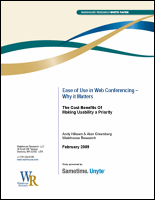Summary
 |
By now, web conferencing has become ubiquitous, with “webinars” becoming the standard term for an online seminar, “virtual classroom” the term for online educational settings, and “web (or online) meeting” the term for a meeting where information is shared from someone’s PC. Users of all stripes, from trainers to sales professionals to engineers – and many others – now use web conferencing for formal and informal knowledge sharing. The economic impact is immense (travel savings, increased productivity, enhanced work/life balance). We have approached a point in time, however, that the positive overall economic impact has come to obscure an area that few consider on a daily basis: is the technology applied as well as it can be? What are we missing if the effort has not been put into making web conferencing as simple to use as possible? Is there a cost when users stumble and struggle to figure out how to use the technology instead of effortlessly, transparently, go about their business?
In October 2008 Wainhouse Research conducted a survey of 173 web conferencing users by gathering their experiences and opinions in three areas – 1) the value of Ease of Use, 2) the hidden costs that occur when Ease of Use is missing in an offering, and 3) the role of Ease of Use in the adoption of web conferencing. The average of the responses reveals that web conferencing would be used for 33% more meetings if it were easier to use. Digging deeper into the detail behind this figure shows that almost half (46%) believe meeting usage would increase 20% to 30% more, while another one-third of respondents (34%) believe the increase would be 50% or more. |
This document, sponsored by IBM Sametime Unyte, offers a quantifiable assessment of the difference an easier-to-use web conferencing service can provide.
Download File (268.00 KB)